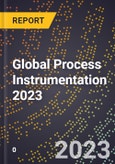Process analytical instruments (PAI) are used for monitoring, modeling, analyzing, and controlling manufacturing processes by promptly measuring critical parameters using analytical techniques familiar from the laboratory. In contrast to their laboratory counterparts, these instruments are designed to automatically receive samples and provide real-time results. Their primary goal is to ensure process safety, optimize operations, and maintain product quality. PAIs have been widely employed in various manufacturing industries, backed by extensive research and development spanning several decades, with the aim to incorporate analytical measurements into manufacturing workflows, thereby enhancing productivity, and meeting regulatory and quality standards.
In the face of backlogs resulting from supply chain disruptions, the manufacturing industry has been relatively insulated from the layoffs recently witnessed in other sectors such as finance and technology. However, as economic conditions shift and supply chain issues have largely resolved, retailers are reducing orders, affecting demand for manufactured goods. This will negatively impact both the workforce and the demand for process analytical instruments, particularly as the manufacturing sector contracts.
Despite this, the high revenues of recent years resulting from pent-up demand have led to healthy balance sheets and significant free cash flows, particularly in industries heavily reliant on PAIs like the chemical, and the oil and gas industries. Although the pharmaceutical industry has exhibited conservative purchasing behavior, the demand for innovative medicines continues to rise, fostering potential investments in PAIs. Additionally, the growing emphasis on energy efficiency and cost reduction has prompted companies to divert cash to newer technologies to optimize existing and future operations.
The COVID-19 pandemic and geopolitical conflicts, such as the Russian invasion of Ukraine, have brought manufacturing practices into sharp focus, and even impacted the processing of food on a global basis. These events have compelled companies to reassess their operations to mitigate labor shortages, high labor costs, supply chain disruptions, and geopolitical issues affecting raw material access and costs, and energy prices. The implementation of process analytical technologies encompassing analytical instrumentation is a critical tool in manufacturing settings. In-line instrumentation provides real-time data, enabling immediate adjustments, as opposed to quality control testing of finished products in the lab to determine if they pass specifications. Without PAIs, if a process fails, it may continue producing out-of-spec products until samples can be taken to the QC lab and tested. PAIs can provide real-time notification of problems, reducing delays and waste. Therefore, despite potential industrial declines in the near future, the significance of PAI tools in maximizing profits, reducing waste, shortening lead times, and increasing product yields will drive growing investments in continuous manufacturing and PAIs to control processes. This growth will not be limited to traditional fields like oil and gas production, chemicals, and semiconductors, but also extend to industries such as food, pharmaceuticals, and biotechnology.
The Global Process Instrumentation 2023 report observes the dynamics and numerous market trends influencing the industry and analyzes their effect on sales growth for instruments used to monitor in real-time and allow for fast process decision and optimization. This report has been crafted to evaluate and explain what is currently driving this important market. The process analytical instrument market in this report includes process electrochemistry, spectroscopy, chromatography, and other products. These instruments are categorized into five different technology groups that compose the overall market.
Report Overview:
Market demand segmented by technique, region, sector, and industry along with yearly market forecasts through 2027. The market estimates have been newly updated with 2022 as the base year and estimates are provided for the following techniques:
- Process Electrochemistry
- Process Spectroscopy
- Process Materials Characterization
- Process Chromatography
- Process Mass Spectrometry
Market opportunities and threats for process analytical instruments and regional trends for the United States & Canada, Europe, China, Japan, India & Other Asia-Pacific, Latin America & the Rest of the World.
Market shares of participating suppliers in each technology category employed by the process analytical instrument industry. Some of the top vendors in the overall market are presented below, in alphabetical order:
- ABB
- Agilent
- AMETEK
- Anton Paar
- Bruker
- Buchi
- Danaher
- DKK-TOA
- Emerson
- Endress + Hauser
- Honeywell
- HORIBA
- Metrohm
- Mettler-Toledo
- Rigaku
- Sartorius
- Siemens
- Spectris
- Thermo Fisher
- Xylem
- Yokogawa
Companies Mentioned
- ABB
- Agilent
- AMETEK
- Anton Paar
- Bruker
- Buchi
- Danaher
- DKK-TOA
- Emerson
- Endress + Hauser
- Honeywell
- HORIBA
- Metrohm
- Mettler-Toledo
- Rigaku
- Sartorius
- Siemens
- Spectris
- Thermo Fisher
- Xylem
- Yokogawa








